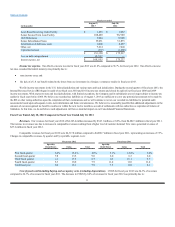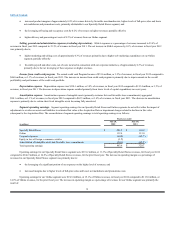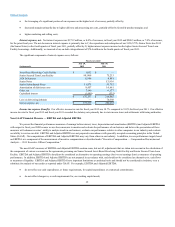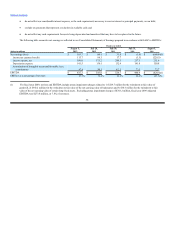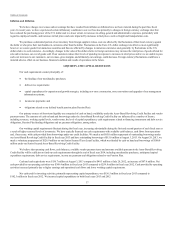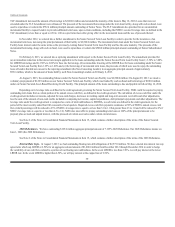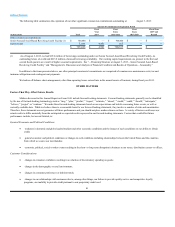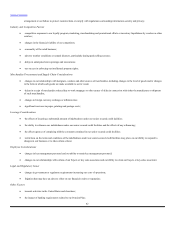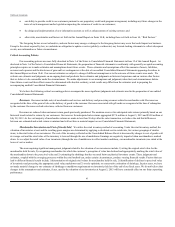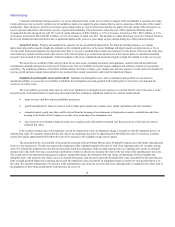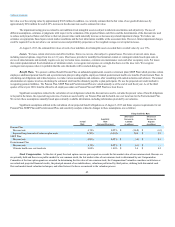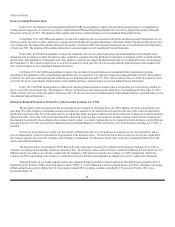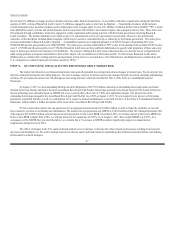Neiman Marcus 2012 Annual Report Download - page 39
Download and view the complete annual report
Please find page 39 of the 2012 Neiman Marcus annual report below. You can navigate through the pages in the report by either clicking on the pages listed below, or by using the keyword search tool below to find specific information within the annual report.
Table of Contents
Inflation and Deflation
We believe changes in revenues and net earnings that have resulted from inflation or deflation have not been material during the past three fiscal
years. In recent years, we have experienced certain inflationary conditions in our cost base due primarily to changes in foreign currency exchange rates that
have reduced the purchasing power of the U.S. dollar and, to a lesser extent, to increases in selling, general and administrative expenses, particularly with
regard to employee benefits, and increases in fuel prices and costs impacted by increases in fuel prices, such as freight and transportation costs.
We purchase a substantial portion of our inventory from foreign suppliers whose costs are affected by the fluctuation of their local currency against
the dollar or who price their merchandise in currencies other than the dollar. Fluctuations in the Euro-U.S. dollar exchange rate affect us most significantly;
however, we source goods from numerous countries and thus are affected by changes in numerous currencies and, generally, by fluctuations in the U.S.
dollar relative to such currencies. Accordingly, changes in the value of the dollar relative to foreign currencies may increase the retail prices of goods offered for
sale and/or increase our cost of goods sold. If our customers reduce their levels of spending in response to increases in retail prices and/or we are unable to pass
such cost increases to our customers, our revenues, gross margins, and ultimately our earnings, could decrease. Foreign currency fluctuations could have a
material adverse effect on our business, financial condition and results of operations in the future.
LIQUIDITY AND CAPITAL RESOURCES
Our cash requirements consist principally of:
· the funding of our merchandise purchases;
· debt service requirements;
· capital expenditures for expansion and growth strategies, including new store construction, store renovations and upgrades of our management
information systems;
· income tax payments; and
· obligations related to our defined benefit pension plan (Pension Plan).
Our primary sources of short-term liquidity are comprised of cash on hand, availability under the Asset-Based Revolving Credit Facility and vendor
payment terms. The amounts of cash on hand and borrowings under the Asset-Based Revolving Credit Facility are influenced by a number of factors,
including revenues, working capital levels, vendor terms, the level of capital expenditures, cash requirements related to financing instruments and debt service
obligations, Pension Plan funding obligations and tax payment obligations, among others.
Our working capital requirements fluctuate during the fiscal year, increasing substantially during the first and second quarters of each fiscal year as
a result of higher seasonal levels of inventories. We have typically financed our cash requirements with available cash balances, cash flows from operations
and, if necessary, with cash provided from borrowings under our credit facilities. We made a net $85.0 million repayment of outstanding borrowings under
our Asset-Based Revolving Credit Facility in fiscal year 2013 and have outstanding borrowings of $15.0 million at August 3, 2013. On August 29, 2013, we
made a voluntary prepayment of $126.9 million on our Senior Secured Term Loan Facility, which was funded by cash on hand and borrowings of $100.0
million under our Senior Secured Asset-Based Revolving Credit Facility.
We believe that operating cash flows, cash balances, available vendor payment terms and amounts available pursuant to the Asset-Based Revolving
Credit Facility will be sufficient to fund our cash requirements through the end of fiscal year 2014, including merchandise purchases, anticipated capital
expenditure requirements, debt service requirements, income tax payments and obligations related to our Pension Plan.
Cash and cash equivalents were $136.7 million at August 3, 2013 compared to $49.3 million at July 28, 2012, an increase of $87.4 million. Net
cash provided by our operating activities was $349.4 million in fiscal year 2013 compared to $259.8 million in fiscal year 2012. Cash provided by operating
activities increased primarily due to higher earnings and operational cash flows and lower working capital requirements.
Net cash used for investing activities, primarily representing capital expenditures, was $156.5 million in fiscal year 2013 compared to
$182.3 million in fiscal year 2012. We incurred capital expenditures in both fiscal years 2013 and 2012
37








